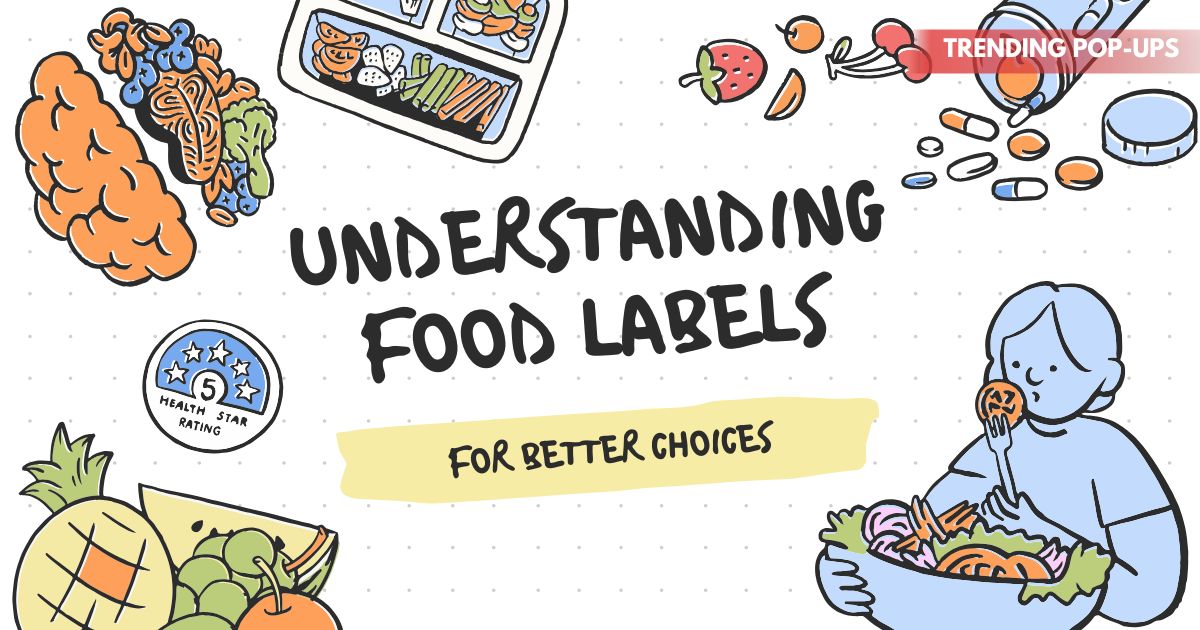In today’s fast-paced world, packaged and processed foods dominate supermarket shelves. While convenience is important, knowing what’s inside the food you eat is even more crucial. This is where food labels come into play. By understanding food labels, you can make better choices for your health, avoid hidden sugars and fats, and ensure you meet your nutritional needs.
This article explores the key components of food labels, why they matter, and how you can use them to make smarter, healthier decisions every time you shop.
Why Food Labels Are Important
Food labels are more than just numbers and jargon—they are nutrition roadmaps. They provide critical information about:
-
Calories per serving
-
Nutrient breakdown (carbohydrates, proteins, fats, vitamins, minerals)
-
Added sugars and sodium content
-
Ingredients and allergens
By reading labels carefully, you can prevent overeating, avoid unhealthy additives, and choose products aligned with your health goals, whether that’s weight management, controlling diabetes, or supporting heart health.
The Nutrition Facts Panel
At the heart of every packaged product is the Nutrition Facts Panel. This section breaks down key details that help you evaluate the product.
1. Serving Size
-
Indicates how much of the product is considered one serving.
-
Always check this first, as all nutritional values are based on serving size.
-
A small packet may contain multiple servings, leading you to consume more calories than intended.
2. Calories
-
Shows how much energy one serving provides.
-
For general health, an average adult needs 2,000–2,500 calories per day, but this varies by age, gender, and activity level.
-
Monitoring calorie intake helps prevent obesity and lifestyle-related diseases.
3. Macronutrients
-
Carbohydrates: Includes total carbs, fiber, and sugars. Opt for higher fiber and lower added sugars.
-
Protein: Supports muscle growth and repair. Aim for adequate intake per serving.
-
Fats: Divided into total fat, saturated fat, and trans fat. Avoid trans fats and limit saturated fat for heart health.
4. Micronutrients
-
Vitamins and minerals like Vitamin D, calcium, iron, and potassium are often listed.
-
Choose foods that help you meet your daily nutrient requirements.
5. % Daily Value (%DV)
-
Helps you understand how much a nutrient in one serving contributes to your daily diet.
-
5% DV or less = low, 20% DV or more = high.
-
Aim for low %DV in sodium and added sugars, and high %DV in fiber and essential vitamins.
Ingredients List: The Hidden Truth
The ingredients list is often overlooked, but it’s one of the most important parts of the label.
-
Order Matters: Ingredients are listed by weight, from highest to lowest. If sugar, refined flour, or hydrogenated oils appear first, the product is less healthy.
-
Identify Additives: Watch for artificial colors, preservatives, and flavor enhancers like MSG.
-
Allergen Information: Labels highlight allergens such as peanuts, soy, milk, and wheat—crucial for people with allergies.
Common Marketing Traps on Food Labels
Food companies often use buzzwords to make products appear healthier than they are. Be cautious of:
-
“Low-fat”: May still contain high sugar.
-
“Sugar-free”: Could include artificial sweeteners.
-
“Whole grain”: Sometimes means only a small percentage of whole grains.
-
“Natural”: Not always regulated, may still contain additives.
Reading the actual nutrition facts is more reliable than trusting front-of-package claims.
How to Use Food Labels for Better Choices
Here are practical strategies to apply when shopping:
Compare Similar Products
Place two brands side by side and compare serving size, calories, sugar, and sodium. Often, healthier choices exist within the same category.
Focus on Fiber and Protein
Select items with higher dietary fiber (for digestion) and protein (for satiety and muscle health).
Limit Sodium and Added Sugar
-
High sodium intake increases the risk of hypertension.
-
Added sugars contribute to obesity, diabetes, and heart disease.
Aim for products with low sodium and minimal added sugars.
Balance Your Diet
Labels allow you to see how a food item fits into your daily requirements. For example, if one product is high in fat, balance it with leaner choices throughout the day.
Benefits of Understanding Food Labels
By developing the skill of reading labels, you gain:
-
Better weight management through calorie awareness.
-
Disease prevention by avoiding excess sugar, salt, and trans fats.
-
Improved nutrition from selecting fiber- and vitamin-rich foods.
-
Empowerment to make conscious, health-oriented decisions rather than being swayed by marketing.
Conclusion
Understanding food labels is not just about numbers—it’s about taking control of your health. From calories to serving sizes, ingredients, and daily values, every detail helps you make an informed choice. By practicing mindful shopping and avoiding marketing traps, you can build a diet that supports long-term wellness.
Next time you pick up a product, turn it around, read the label carefully, and let knowledge guide your decisions.
Also Read : Low-Carb Diet: What You Need to Know for Weight Loss and Health
FAQs
Q1. What is the most important thing to check first on a food label?
The serving size, because all other nutritional values are based on it.
Q2. How much added sugar is considered acceptable?
The American Heart Association recommends limiting added sugars to 25g/day for women and 36g/day for men.
Q3. Are “organic” products always healthier?
Not necessarily. Organic refers to how ingredients are grown, but the product may still contain high calories, sugar, or fat.
Q4. What does % Daily Value mean?
It shows how much one serving contributes to your daily nutritional needs, based on a 2,000-calorie diet.
Q5. Why is sodium on labels important?
High sodium intake raises blood pressure and increases the risk of heart disease. Checking sodium levels helps maintain cardiovascular health.



